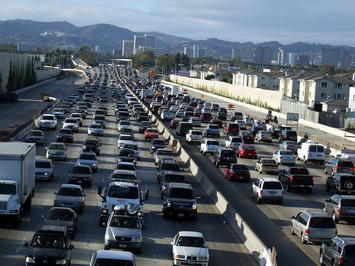
A new study from accounting firm KPMG predicts that auto travel in the United States will be 9 to 10 percent less after the pandemic than it was before. Telecommuting, says the report, will lead to a 10 to 20 percent reduction in commuting by car while on-line shopping will lead to a 10 to 30 percent reduction in shopping trips.
This is good news to the transit-loving, auto-hating folks at Streetsblog, who celebrate “14 million cars off the road forever” but warn that “if we don’t act fast, they’ll come back” (which makes “forever” somewhat dubious). The “actions” they advocate call for giving the transit industry another $32 billion right away so it can keep its empty transit vehicles clean and even more money after that so it can increase the frequencies of those empty buses and trains.
If you believe the KPMG report, however, that’s not going to work. The report also found that 43 percent of former transit riders don’t plan to go back to riding transit after the pandemic, and most of them will substitute autos for transit. If true, that will increase driving by about 5 billion vehicle miles. KPMG admitted that transit’s loss would somewhat offset the decrease in auto travel, but did not include that in its calculations.
Indeed, KPMG’s overly simplistic study failed to account for many possible interactions in the transportation sector. It asked transit users if they planned to switch to single-occupancy vehicles, carpools, or ride hailing, but didn’t ask how many expected to end up telecommuting. It asked how many cars would be taken off the road because of telecommuting, but it didn’t ask how many more would be added to the road as people take advantage of lower congestion.
Randall Crane, an urban planner now at UCLA (but formerly at UC Irvine), once did a study of telecommuting that found that people who work at home don’t necessarily drive less than people who commute by car — they just drive at other times of the day, since working at home gives them flexibility to set their own hours. On-line shopping may reduce driving for shopping, but what if people take the extra time they save from not shopping and use it to travel for recreation or social reasons? KPMG is silent about such questions.
The headline-grabbing numbers in the KPMG report are the maximums of its estimates. “We estimate that total U.S. VMT could drop by 140 billion to 270 billion miles per year,” says the report, which is 5 to 9 percent, not 9 to 10 percent. That drop in driving, the report continues, could reduce auto ownership “from 1.97 to as little as 1.87 vehicles per household” which is 7 to 14 million vehicles.
Yet driving has proven to be far more resilient than transit ridership. According to the Bureau of Economic Analysis (click on table 2.2.5), Americans have consistently spent about 9 percent of their personal incomes on driving for the last 70 years. As the cost of driving has declined relative to personal incomes, people drive more.
Most of that increase in driving hasn’t been commuting and shopping, which represent less than half the driving Americans do. If future Americans don’t have to spend so much time shopping or commuting to work, they will spend more time driving for family, social, and recreational activities.
Nor do auto makers need to worry much that the American auto fleet is going to shrink by 14 million vehicles. According to Global Workplace Analytics, most post-COVID telecommuters will work at home only part time, continuing to go to another workplace one or more days a week. They’ll still need cars for that.
In addition, experience indicates that, when gas prices fall, people use the savings to buy bigger, more luxurious automobiles. This suggests any households that decide to have one less car because one of the income-earners is working at home will, the next time they buy a car, use the savings to buy one that is more luxurious than they previously owned. Auto companies probably earn more profits from the sale of one luxury car than two commuter cars.
Transit, on the other hand, is far less resilient than driving. Citing Streetlight Data, the KPMG report says that driving fell by 64 percent in April, 2020. According to the Federal Highway Administration, it was only 42 percent compared with the previous April. Since gasoline consumption was down only 37 percent, the FHwA number sounds closer to reality. Transit ridership, meanwhile, fell by 84 percent.
What the KPMG report doesn’t say is that May driving was only 25 percent less than the May before, meaning that it had recovered 40 percent of its loss. May transit ridership was still down by 81 percent, so it recovered only 4 percent of its loss. We should have June numbers next week, but I expect that driving will again recover more of its decline than transit.
What this means is that anyone who proposes or makes transportation policy based on a projected 9 to 10 percent decline in driving and 14 million fewer vehicles is going to be disappointed. The good news is that there is likely to be less rush-hour driving on congested roads. The even better news for the economy, if not for auto-haters, is that overall driving is likely to recover to pretty close to what it was before the pandemic and will continue to grow after that.
This piece first appeared on The Antiplanner.
Randall O'Toole (rot@ti.org) is an economist with forty years of experience critiquing public land, urban, transportation, and other government plans.
Photo credit: Tatiane Santos via Flickr under CC 2.0 License.












